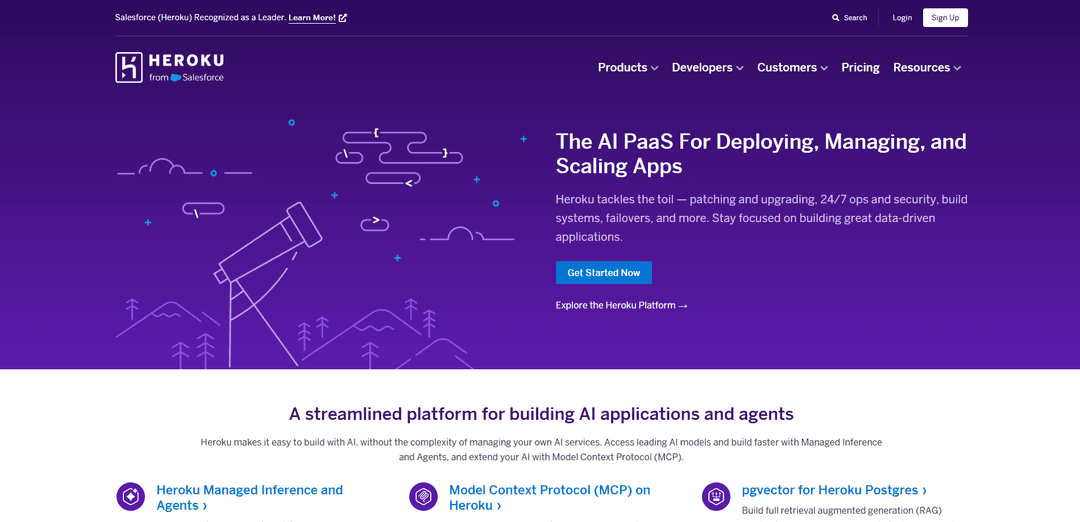
Heroku
Heroku is a fully-managed cloud platform as a service (PaaS) that enables developers to build, deploy, manage, and scale applications using multiple programming languages while handling infrastructure management.
https://www.heroku.com/?ref=producthunt

Product Information
Updated:Oct 16, 2025
What is Heroku
Heroku is a cloud application platform that provides developers with a streamlined path to building and deploying applications without worrying about infrastructure management. Founded with initial support for Ruby on Rails, it has now expanded to support multiple programming languages and has helped deploy over 9 million apps. The platform offers both a command-line interface (CLI) and web-based dashboard for managing applications, making it accessible for developers of all skill levels, from students building their first apps to enterprise teams deploying business-critical applications.
Key Features of Heroku
Heroku is an AI Platform as a Service (PaaS) that provides developers with a fully managed cloud environment for building, deploying, and scaling applications. It offers support for multiple programming languages, automated infrastructure management, integrated data services, and AI capabilities through Managed Inference and Agents. The platform streamlines development workflows with features like continuous deployment, monitoring tools, and an extensive ecosystem of add-ons while handling operational tasks like security, scaling, and maintenance.
Managed Container System: Applications run in smart containers called dynos that provide isolated, reliable runtime environments with automatic scaling and management capabilities
Integrated Data Services: Built-in support for databases like Heroku Postgres and Redis, offering features such as continuous protection, rollback, high availability, and vector similarity search with pgvector
AI Development Tools: Managed Inference and Agents platform that simplifies AI integration, allowing easy access to powerful models and tools through simple CLI commands and Model Context Protocol (MCP)
Continuous Delivery Pipeline: Seamless integration with GitHub, automated deployments, review apps for pull requests, and easy rollback capabilities for code and database changes
Use Cases of Heroku
Startup Application Development: Perfect for startups needing to quickly build and deploy MVPs without managing complex infrastructure
Enterprise Solutions: Supports large organizations with features like SSO, team management, and compliance certifications for building business-critical applications
AI-Powered Applications: Enables developers to build and deploy AI applications with integrated machine learning models and vector databases
E-commerce Platforms: Scalable infrastructure that can handle varying traffic loads, from small online stores to Black Friday-ready enterprise commerce sites
Pros
Simple deployment and management process requiring minimal DevOps expertise
Extensive ecosystem of add-ons and integrations
Built-in security and compliance features
Cons
Can become expensive when scaling to larger workloads
Limited customization options compared to traditional IaaS platforms
Restricted to specific instance types and configurations
How to Use Heroku
Sign up for Heroku: Create a free Heroku account by visiting signup.heroku.com. The signup form is straightforward and takes less than a minute to fill. You'll get free dyno hours for running free apps.
Install Heroku CLI: Download and install the Heroku Command Line Interface (CLI) from Heroku's website. This will allow you to manage your apps from the terminal. For Windows users, you may need to click 'More info' and 'Run anyway' if you see a security warning.
Login to Heroku CLI: Open terminal/command prompt and run 'heroku login'. This will open your browser for authentication. After verifying credentials, the CLI will log you in automatically.
Create a new Heroku app: Run 'heroku create' to create a new app on Heroku. This will generate a random name for your app and create a git remote called 'heroku'.
Prepare your application: Create a Procfile in your app's root directory to tell Heroku what commands to run. For web apps, include 'web: command-to-start-app'. Also ensure your app listens on the port specified by Heroku's PORT environment variable.
Deploy your application: Use Git to deploy: 1) git add . 2) git commit -m 'initial commit' 3) git push heroku master. Alternatively, connect your GitHub repository through Heroku's dashboard for automatic deployments.
Configure add-ons: Add databases or other services through the Resources tab in Heroku dashboard or via CLI. For example, 'heroku addons:create heroku-postgresql' to add a PostgreSQL database.
Monitor your app: Use 'heroku logs --tail' to view logs. Check app metrics and performance through the Heroku dashboard. Scale dynos up or down as needed using 'heroku ps:scale web=X' where X is the number of dynos.
Heroku FAQs
Heroku is a cloud application platform that helps teams deploy, manage, and scale applications. It provides a fully managed platform where developers can focus on building applications without worrying about infrastructure management, including features like automatic patching, 24/7 ops and security, build systems, and failovers.
Popular Articles

FLUX.2 vs Nano Banana Pro in 2025: Which one do you prefer?
Nov 28, 2025

How to Use Nano Banana Pro Free in 2025 — Complete Guide (Step-by-Step)
Nov 26, 2025

Claude Opus 4.5: The Best Model for Coding, Agents & Computer Use (Full Guide)
Nov 26, 2025

Pixverse Promo Codes Free in 2025 and How to Redeem
Nov 26, 2025







